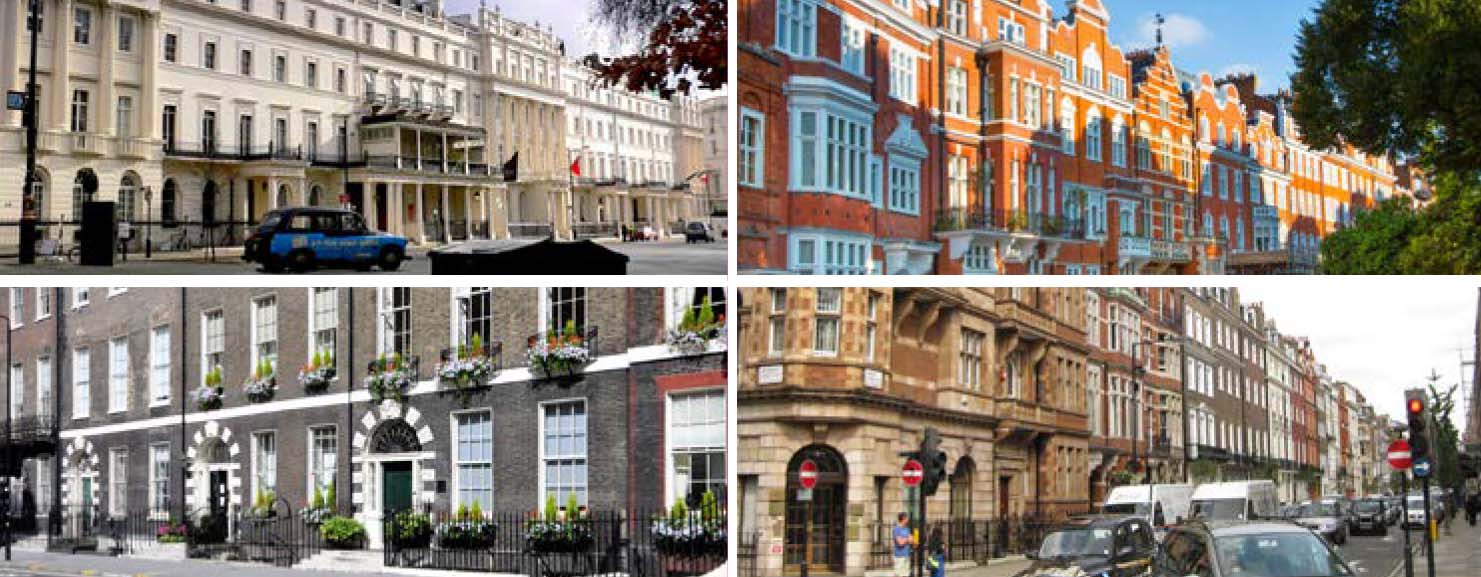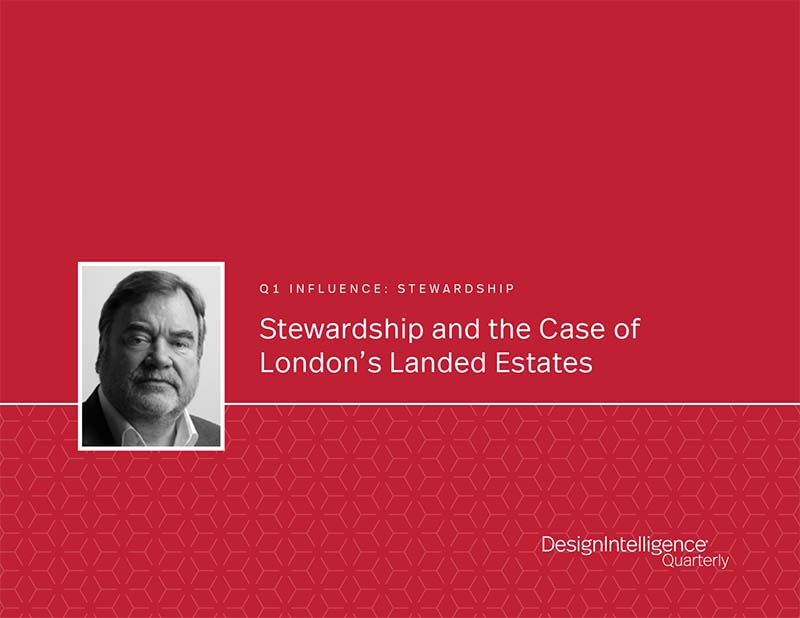Stewardship and the Case of London’s Landed Estates
by Paul Finch
Programme Director, World Architecture Festival
February 2, 2022
Letters from London:
Paul Finch examines leadership’s privileges and responsibilities.
London is unusual in terms of development and ownership of large areas in the middle of the capital. They are controlled by what started as aristocratic or royally owned agricultural estates but have transformed into huge trusts and associated subsidiary companied, mostly still controlled by family interests.
The names of these areas are redolent of historic families: Grosvenor, Cadogan, de Walden, Portman and Bedford, to which one might add quasi-public owners such as the City of London Corporation and the Crown Estate. The areas where they have substantial interests include large parts of Westminster (the West End, St James’s, Soho and Belgravia), Marylebone, Bloomsbury and other generally wealthy parts of central London.
What distinguishes these owners is their attitude to stewardship of assets, their appreciation of the long-term benefits of high-quality development (including investment in design and construction), and their interest in generational succession plans. Each is usually responsible to trustees or commissioners, rather than boards of directors; beneficial ownership is based on freeholds rather than leaseholds; and they are not subject to the vagaries of the stock market or short-term banking policies.
You might say the economic transition from low-value farmland or rented small-scale properties to what we see today, where asset values are measured in billions of pounds, owes much to the 17th-century economist and property speculator Nicholas Barbon. Barbon believed in the benefits of low interest rates, free trade, mortgage finance and insurance, the last two factors triggered by the Great Fire of London in 1666. Barbon used unstable post-fire market conditions to promote fire insurance, but more importantly, to think about the potential benefits of exploiting existing real estate assets by raising mortgages on them to finance new development.
This idea was taken up with enthusiasm, not simply by speculators such as Barbon himself, but eventually by slower-moving aristocratic owners: Provided they could sell leasehold interests in property assets developed on low-value sites, they could not only repay the mortgages, but retain long-term ownership of the land on which the development stood, along with the buildings created.
While this is a simplification of a more variegated process, it is the underlying story of how London’s landed estates became what they are today. Asset management is now more important than it was, but development — sometimes redevelopment — on estate land continues, with more adventurous activities on the part of some in overseas markets.
The most obvious example of this is the Grosvenor Estate, which is owned by the Grosvenor Group, a privately-owned international property company. As its website explains, “With a track record of over 340 years, we develop, manage and invest with a purpose of improving property and places to deliver lasting commercial and social benefit. We achieve our purpose by adopting a farsighted approach, being locally engaged and sharing and benefiting from our internal experience — we call this our Living Cities approach.”

While the language is modest, it represents the voice of an operation with assets worth more than $60 billion, with assets in virtually every continent, including substantial holdings across the U.S. The ultimate overseer of this empire is the Duke of Westminster, whose family ancestry dates back to the invasion of England by the Normans in 1066. The family was given estates in the northwest of England, and for many generations, investment in their part of the country has taken place in addition to the far more important activities undertaken in London and overseas.
To give an example of the long-term attitude of Grosvenor and the family, one could look at the development of the Liverpool One project, which has transformed the middle of that city in the early part of this century with a retail-led mixed-use development. This included the commissioning of 30 good architects, working to an overall masterplan, which has breathed fresh life into what was an ailing city center. The decade-long project ran into financial and construction problems — at one stage it was conceivable that the completion phase would be canceled or reduced in quality to cut costs. In the end, the Grosvenor ethic of investing for the future, and out of respect of past family history and tradition, meant the project was completed as originally intended.
Grosvenor’s association with London property began in 1677, when land to the west of the City of London came into the family after
heiress Mary Davies married Sir Thomas Grosvenor. In the next century, development of pastures, swamps and orchards took place, creating
Mayfair, with Belgravia following in the 19th century. It was another century before another major initiative took place: international
investment beginning in
the 1950s.

London development areas are controlled by estates, mostly still controlled by family interests. Left top: Belgrave Square, one of the most prestigious addresses within the Grosvenor Estate; Left bottom: Bedford Square; Right top: Cadogan Estate; Right bottom: the intersection of Harley Street and Wigmore Street which is part of the Howard de Walden Estate.
A piquant connection between Grosvenor and the U.S. government concerns the former American embassy in London, which from 1938 until recently was based in Grosvenor Square, switching addresses to an imposing Saarinen-designed presence, survives to this day, in 1960. The embassy was always an oddity in the U.S. diplomatic real estate portfolio because of the lease arrangement with the Duke of Westminster. Almost all other major properties are owned outright by the U.S. The duke reportedly said he would only sell the freehold on the Grosvenor Square site if the U.S. government returned his family’s land — confiscated during the American Revolution!
A different form of stewardship, again based on retail ownership, is evident in the way in which Marylebone High Street has been “curated” by the Howard de Walden estate over many decades, gradually upgrading what was once described as a “shabby” area into a gentrified mix of fashion, restaurants and other uses. In this instance, the long-term interests of the estate have allowed decisions to be made that increase overall value through choice of tenant and activity rather than immediate rental return, a general feature of the attitude of the landed estates.
The same is true of the Crown Estate, which, like many British institutions, is an oddity based on a long history. It sounds from its name as though it owns properties on behalf of the monarch, and indeed the concept of crown land stems largely from the same 11th-century Norman Conquest that involved the Grosvenor family. But for many decades, while in theory the estate properties belonged to the crown, in reality, the legislation which created the Crown Estate in the 1950s, means that the monarch has no control over management decisions. All net profits are returned to the UK Treasury each year. The quid pro quo is that the taxpayer, via Parliament, funds many aspects of royal expenditure.
This does not mean that individual royals do not own land of their own. For example, the Duchy of Cornwall, which has extensive landholdings in that county in the southwest of England and elsewhere, “belongs” to Prince Charles. But again, his rights over the estate are at least partly dependent on government approval of development and disposal projects.
Why do the apparent anomalies of landed estates and complicated semi-public organizations like the Crown Estate continue? By and large, these estates have a higher reputation for responsible development than development companies in the private sector, and municipal attempts to echo the long-term attitudes of organizations based on hereditary principles rather than the ballot box. It is also the case that the philanthropic activities associated with the landed estates have built up a legacy of goodwill, as have their relationships with their institutional tenants. For example, the Howard de Walden estate is the freeholder of the Royal Institute of British Architects building in Portland Place; the Bedford Estate is the freeholder of the premises occupied by the Architectural Association in Bedford Square.
Long-term stewardship has also given the landed estates a sense of perspective about politics, economics, construction and the management of assets, coping with boom and bust and societal change over long periods largely unknown to private companies and public authorities.
An example of this is the response of these historic owners of buildings to the new requirements to conserve energy and reduce carbon
generation.
This is not easy in a context where much of your estate may be subject to legislation, which makes alteration of listed historic buildings
difficult territory. Balancing the requirements of environmental initiatives with duties to preserve heritage is no easy matter, but in the
case of the landed estates, there will be precedent to draw on and the inevitable authority of real estate stewardship, which may date back
centuries.
You might say that the failures associated with a moribund, class-based social structure have been addressed head-on by the family estates that have survived in London and elsewhere in Britain. Survival depends on looking forward while respecting heritage and tradition, bringing in external expertise rather than assuming that mere ownership confers skill and experience, and being alert to the direction the political and economic winds are blowing.
The current (seventh) Duke of Westminster, Hugh Grosvenor, is a graduate in countryside management and was named by the Sunday Times as the richest under-30 person in Britain, with net personal wealth of more than £10 billion. Like his predecessors, he is a philanthropist as well as the person ultimately responsible for the success of his extraordinary inheritance.
With privilege comes responsibility.
Paul Finch is Programme Director of the World Architecture Festival (WAF). He started professional life as a journalist in the early 1970s; he has edited Building Design, Architects’ Journal and Architectural Review, where he launched WAF in 2008. He has been co-editor of Planning in London since 1994. He was a founder-commissioner and later chair at CABE (the UK government’s Commission for Architecture & the Built Environment) where he also chaired its design review programme, subsequently chairing its London Olympics design panel from 2005 to 2012. He holds an honorary doctorate from the University of Westminster and honorary fellowships from University College London and the Royal Institute of British Architects. He is an honorary member of the British Council for Offices and the Architectural Association. He was awarded an OBE for services to architecture in 2002. With this essay he initiates a series entitled Letters From London.


